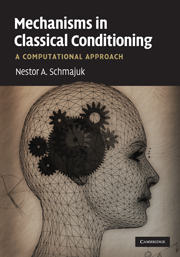Book contents
- Frontmatter
- Contents
- Preface
- Acknowledgments
- Abbreviations
- Part I Introduction
- Part II Attentional and associative mechanisms
- Part III Configural mechanisms
- Part IV Attentional, associative, configural and timing mechanisms
- 14 Configuration and timing: timing and occasion setting
- 15 Attention and configuration: extinction cues
- 16 Attention, association and configuration: causal learning and inferential reasoning
- Part V Conclusion: mechanisms of classical conditioning
- References
- Author Index
- Subject Index
14 - Configuration and timing: timing and occasion setting
from Part IV - Attentional, associative, configural and timing mechanisms
Published online by Cambridge University Press: 23 May 2010
- Frontmatter
- Contents
- Preface
- Acknowledgments
- Abbreviations
- Part I Introduction
- Part II Attentional and associative mechanisms
- Part III Configural mechanisms
- Part IV Attentional, associative, configural and timing mechanisms
- 14 Configuration and timing: timing and occasion setting
- 15 Attention and configuration: extinction cues
- 16 Attention, association and configuration: causal learning and inferential reasoning
- Part V Conclusion: mechanisms of classical conditioning
- References
- Author Index
- Subject Index
Summary
Buhusi and Schmajuk (1999) presented a neural network model of conditioning that combines the SD/SLH configural model presented in Chapter 11, with a timing model offered by Grossberg and Schmajuk (1989). The Grossberg and Schmajuk (1989) timing model incorporates a mechanism by which a CS can predict the time when the US is presented. In this timing model, stimuli evoke multiple traces of different duration and amplitude, that peak at different times after CS presentation. In the “configural–timing” model offered by Buhusi and Schmajuk (1999), these traces compete to become associated directly and indirectly (through hidden units) with the US, as described in Chapter 11. The output of the system predicts the value, moment and duration of presentation of reinforcement.
Most interestingly, and in contrast to the SD/SLH model, in the configural–timing neural network described in this chapter, a stimulus may assume different roles (simple CS, occasion setter, or both) at different time moments. Moreover, while in the SD/SLH model competition between CSs is purely associative, in the configural–timing model competition between CSs is both associative and temporal. CSs compete to predict not only the presence and the intensity of the US, but also its temporal characteristics: time of presentation and duration. The configural–timing model is able to address both the temporal and associative properties of simple conditioning, compound conditioning and occasion setting.
- Type
- Chapter
- Information
- Mechanisms in Classical ConditioningA Computational Approach, pp. 359 - 391Publisher: Cambridge University PressPrint publication year: 2010



